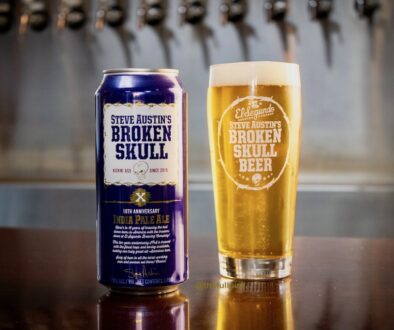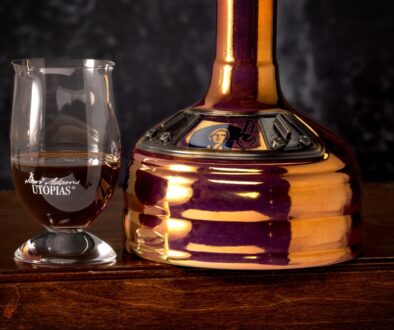Samuel Smith’s Yorkshire Stingo & Barrel-Aged Beers
 Samuel Smith’s Brewery, the oldest in Yorkshire England and still proudly independent, holds a cherished position in the American craft beer renaissance: 30 years ago Samuel Smith’s Pale Ale, Oatmeal Stout, and Taddy Porter were the first handmade, all-malt beers many Americans ever tried.
Samuel Smith’s Brewery, the oldest in Yorkshire England and still proudly independent, holds a cherished position in the American craft beer renaissance: 30 years ago Samuel Smith’s Pale Ale, Oatmeal Stout, and Taddy Porter were the first handmade, all-malt beers many Americans ever tried.
Maintaining this pioneering position, Samuel Smith’s Old Brewery and importer Merchant du Vin are proud to announce the U.S. introduction of Samuel Smith’s Yorkshire Stingo. This barrel-aged, bottle-conditioned strong ale expresses the elegant refinement of every Samuel Smith’s beer, but with depth, length and power found in no other beer. This is a must-try beer: Extreme meets over 250 years of brewing experience.
Vintage dated, Stingo will be available nationally each year around England’s “Yorkshire Day,” August first. Production of this fine ale will be extremely limited.
A traditional strong ale that originated in the north of England, “Stingo” is mentioned in literature before 1700. Samuel Smith’s Stingo melds the signature elegance of the brewery’s ales with a long historical tradition. Brewed from British malts and multiple hop varieties, Stingo is fermented in open-topped stone Yorkshire Squares, then aged over a year in oak barrels that previously held cask-conditioned ale, gaining subtle complexity from the wood. Some of the barrels at Samuel Smith’s are over a century old – if a cask is damaged, the coopers carefully replace broken staves and put the cask back into service.
Samuel Smith’s Stingo shows rich, superb flavors of toffee, raisin, dried fruit, and caramel; waves of flavor ascend and ebb leaving soft oak notes. Hops add a perfect enhancement to dramatic malt and fermentation flavors, but without pushing bitterness past the point of balance. Bottle conditioning – that is, including live yeast in each bottle – produces soft carbonation, a fruity aroma and finish, and allows Stingo to age and develop in the bottle.
Serve Stingo alone as the ultimate digestif, or pair with beef, wild game, or demanding, deeply-flavored foods like pickled fish or strong aromatic cheeses. Try with lamb, duck, smoked meats, or Kalamata olives; serve in a nonik glass or red wine glass, and remember to pour gently, leaving the remaining brewers yeast behind in the bottle.
Click Here for more info on Yorkshire Stingo
Here is more about Samuel Smith’s Old Brewery, est. 1758.
Barrel-Aged Beers
Over the past few years, we’ve noted more breweries beginning to use wooden barrels to provide flavor enhancements to their specialty beers. Although we have been importing beers-from-the-wood for many years, the introduction of Samuel Smith’s Yorkshire Stingo serves as a good opportunity to talk about using wooden vessels in a brewery.
Wooden barrels – generally oak – were the primary vessel for beer storage and shipment for centuries. Barrels could be made by hand tools, and they could also be repaired by hand when damaged. Only with the industrial revolution – say within the past 150 years – did glass bottles and steel kegs became the materials of choice for beer packaging.
But in addition to holding & transporting beer, barrels added inimitable flavors to beer, sometimes subtle and other times forward. There are different ways that oak casks contribute flavors to beer:
Wineries often use new oak, or a percentage of some new oak and some old. (Barrels that have previously been used will offer less wood flavor.) Bourbon distillers use new oak barrels that have been charred inside, and in fact bourbon gets its amber color from the barrel: the spirit that comes from the still is clear. Brewers generally do not use new oak barrels.
For decades and even centuries, brewers of Belgian lambics and Flanders brown & red ales have used barrels or wooden tuns (essentially, huge barrels) that have microorganisms living within the wood. The barrel or tun is filled with fermented beer, which provides food to the yeast strain brettanomyces (“brett”) that is established there in the wood; some barrels may also have different strains of bacteria dwelling there as well. In turn, the beer gains sour, sharp, intense or “barnyard” character – demanding, unique flavors which are beloved by many. (Buy a bottle of Lindemans Cuvée René if you have never experienced a sour beer – it’s acidic, tart, sharp, unusual, and amazing . . . but possibly not for everyone.) In recent years, some American craft breweries have started to use “infected” barrels to produce wonderful sour beers.(Note: Orval Trappist Ale is considered the ultimate “brett” beer by many brewers and connoisseurs, but it’s not barrel-aged – the brett is added at bottling time.)
Rum, whiskey, and port barrels are sometimes used to hold beer as well, providing flavor to the beer that reflects what the barrels held previously – in a melding of flavors & balance that is sometimes compelling. Some breweries do limited edition beers, usually strong and frequently stouts, that have been aged in a spirits barrel.
Samuel Smith’s still uses oak barrels for cask-conditioned beer served in England. Employing a full-time cooper, the brewery can repair barrels by replacing staves that have broken, adding some new wood; most of these barrels have been filled and refilled with ale many times. By the time these casks are used to age Stingo, the wood has reached a beautifully balanced subtle state, perfect to add the gentle oak notes in character with the powerful refinement of the beer. We don’t know of another brewery that ages strong ale in casks that previously held ale from the same brewery!
Another factor in barrel aging is the very slow evaporation of the liquid through the wood (the evaporated beer – or wine, or spirits – is known as the “angel’s share”), and the corresponding introduction of minute amounts of air through the wood. This process, really a very slow, controlled oxidation, leads to a depth of flavor that can be gained no other way – it’s the same process that occurs when a fine wine designed for aging gains majesty through years in the cellar.
The final step before packaging a barrel-aged beer is careful tasting by the brewer. As the flavor changes over time, the brewer decides when to bottle the beer; at lambic breweries batches of different ages are blended before bottling, always with flavor in mind.
Whatever barrels are used – venerable ale barrels, old barrels that hold colonies of established microorganisms, or spirits barrels – barrel-aging is another mix of magic and science that brewers use to provide us with wonderful and exciting flavors.




July 16, 2009 @ 5:12 pm
Yep, I’d love to try this as well. Any idea if its coming to the States? August is fast approaching!
July 16, 2009 @ 4:24 pm
This is a very exciting prospect! How can I lay my hands on some?
July 16, 2009 @ 6:19 pm
Michael, look out for where ever Samuel Smith stuff is sold in your area.